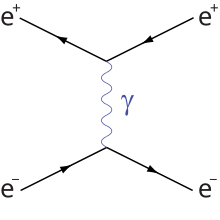Bhabha dispersion
The Bhabha scattering , named after the Indian physicist Homi J. Bhabha is a quantum electrodynamic scattering process between a particle and its antiparticle, for example between electron and positron . The natural system of units for particle physics is used for the formulas .
Scattering process
definition
The scattering process of bhabha scattering can be expressed by the equation
describe. A virtual photon is generated and destroyed as an exchange particle of the electromagnetic interaction. The quantum electrodynamic scattering processes can be clearly illustrated by Feynman diagrams , which can be translated into stringent mathematical expressions for cross sections. Since virtual particles cannot be observed, all connected Feynman diagrams with an incoming and outgoing electron-positron pair must be considered.
The diagram on the left describes a classic electrodynamic scattering process in which the electron and positron are subject to electromagnetic interaction via a long-range effect; the right a process which can only be explained by the creation and annihilation of particles in quantum field theories. Based on the Mandelstam variables , the left process is called the t-channel and the right s-channel.
Matrix elements
The matrix element of the Bhabha scattering is due to the Dirac statistics Fermi from the difference of the matrix elements of the single scattering processes. Denote the four pulses of the incoming or outgoing positron and that of the electron, the Dirac matrices and as well as the Dirac Spinors for particles or antiparticle. A dash above a spinor stands for the Dirac adjoint and is the elementary charge .
Then according to the Feynman rules of quantum electrodynamics:
The Lorentz-invariant Mandelstam variables and , which give the names of the corresponding channels, appear in the denominators . The entire matrix element is therefore:
To convert the matrix element into an effective cross-section, you need its square of the magnitude. Since the spin settings of the electron-positron pair are usually not known before the scattering process and the settings after the process are irrelevant, the spin-averaged squared matrix element appears in the cross-section , which can be greatly simplified using Casimir's trick :
- .
The first term describes the interaction via the t-channel, the second that via the s-channel and the third is the interference term from the squaring.
Difference to the Møller scattering
In contrast to Møller scattering , which describes electron-electron scattering, the objects involved in Bhabha scattering are distinguishable. This leads to the fact that no u-channel process occurs from the swapping of the two scattering partners compared to the t-channel. In contrast, electron and positron are their respective antiparticles, so that the s-channel process can take place as an annihilation pair creation process.
Cross section
Differential cross section
In contrast to the Lorentz-invariant matrix element, the differential cross-section depends on the reference system, since the solid angle element depends on the selected reference system. It is advisable to carry out all calculations in the center of gravity system and then, if necessary, to subject them to a Lorentz transformation into any other, for example the laboratory system.
The following applies in the priority system:
High-energy borderline case
The high-energy (relativistic) limit case is defined by the fact that the center of gravity energy is large compared to the electron mass. This simplifies the matrix element too
- ,
when the kinematic variables are expressed by the Mandelstam variables . It is the third, not from and independent Mandelstam variables. In this representation, the crossing symmetry between the s and t channels can be seen, since all occurring quantities are symmetrical in these two variables (this is, however, already approximately the case).
The differential cross section is therefore
- .
If the Mandelstam variables are also expressed in terms of the energy of the scattering partners, the included scattering angle and the fine structure constant , the differential cross section results:
This decomposition makes the structure of the scattering visible, since the first term indicates the classical expectation from the Rutherford scattering of two charged particles and the second represents the quantum electrodynamic and spin correction.
literature
- David Griffiths: Introduction to Elementary Particle Physics . (Translated by Thomas Stange). Akademie-Verlag, Berlin 1996. ISBN 3-05-501627-0 .
- Michael E. Peskin and Daniel V. Schroeder. An Introduction to Quantum Field Theory . Perseus Books Publishing 1995, ISBN 0-201-50397-2 .
Individual evidence
- ^ Daniel V. Schroeder: Electron-Positron Scattering. (pdf) Retrieved October 8, 2018 .
































